High-Impact Visuals: With various pixel pitches available from 2mm, 2.5mm, to 3mm, and high brightness levels readable under sunlight, your advertisements will pop, rain or shine, ensuring maximum readability and impact.
Exploring Triangle LED Displays: A Guide to Innovative Visual Solutions
In the realm of visual technology, the demand for unique and impactful display solutions has significantly risen, particularly in settings that command high audience engagement. **Triangle LED displays**, a niche yet increasingly popular choice, cater to this demand by offering unconventional and eye-catching visual experiences. Known for their versatility and distinct geometric shape, these displays have become a staple in creative design, particularly in event staging, art installations, and architectural embellishments.

What is a Triangle LED Display?
A triangle LED display, as the name suggests, is an LED panel configured in a triangular shape. This type of display is constructed using several LED modules or panels that align to form the geometric shape, making it a standout feature in any installation. The unique configuration not only enhances the aesthetic appeal but also allows for innovative uses in various applications, from advertising to art and beyond.
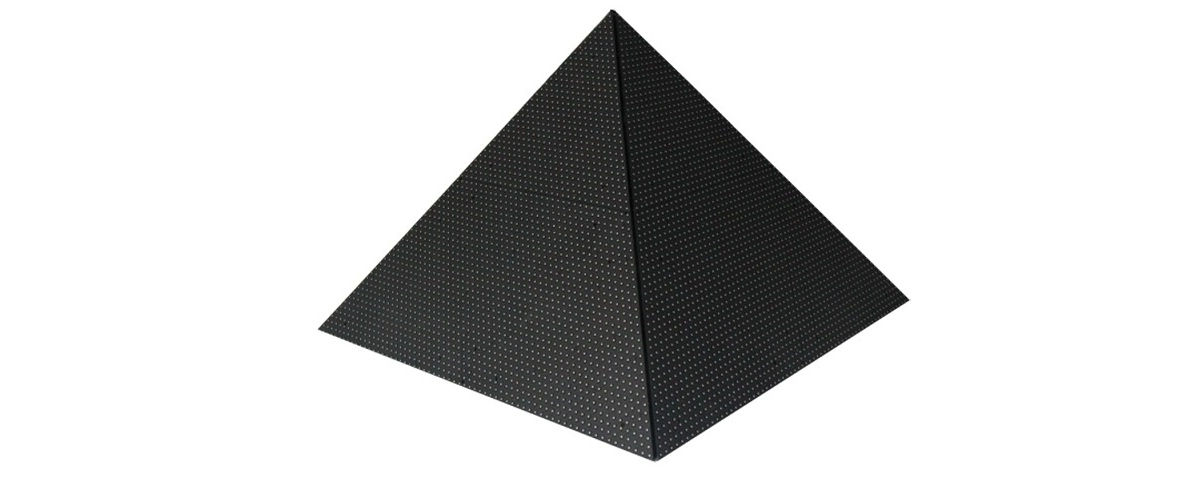

Shape and Configuration: Composed of lightweight, slim LED panels, these displays are designed for easy assembly and maintenance, forming a seamless triangular configuration.
– Customization and Flexibility: Tailoring a triangle LED display to specific requirements is straightforward, thanks to customizable size, resolution, and pixel pitch options. The modular nature of these panels supports the creation of both small and large-scale displays.
– Seamless Integration: These displays ensure a smooth and continuous display surface, allowing for uninterrupted visuals across the entire structure.
– Content Control and Creation: Equipped with advanced software and control systems, triangle LED displays support intricate content management and real-time updates, enhancing viewer engagement.
– Creative Applications: The triangular form opens up endless possibilities for innovative designs, including 3D effects and complex geometric patterns.
Enhance your stage and event designs with our innovative Triangle Shape LED Display for rental. Perfect for creating eye-catching setups, this versatile display offers endless possibilities to elevate visual experiences. Its unique triangular configuration allows for seamless integration into diverse designs, from dynamic backdrops to intricate geometric patterns. Lightweight and easy to install, our Triangle Shape LED Display is ideal for both temporary events and touring productions, ensuring stunning visuals that captivate and engage audiences at every angle. Transform ordinary events into extraordinary spectacles with our cutting-edge LED technology.
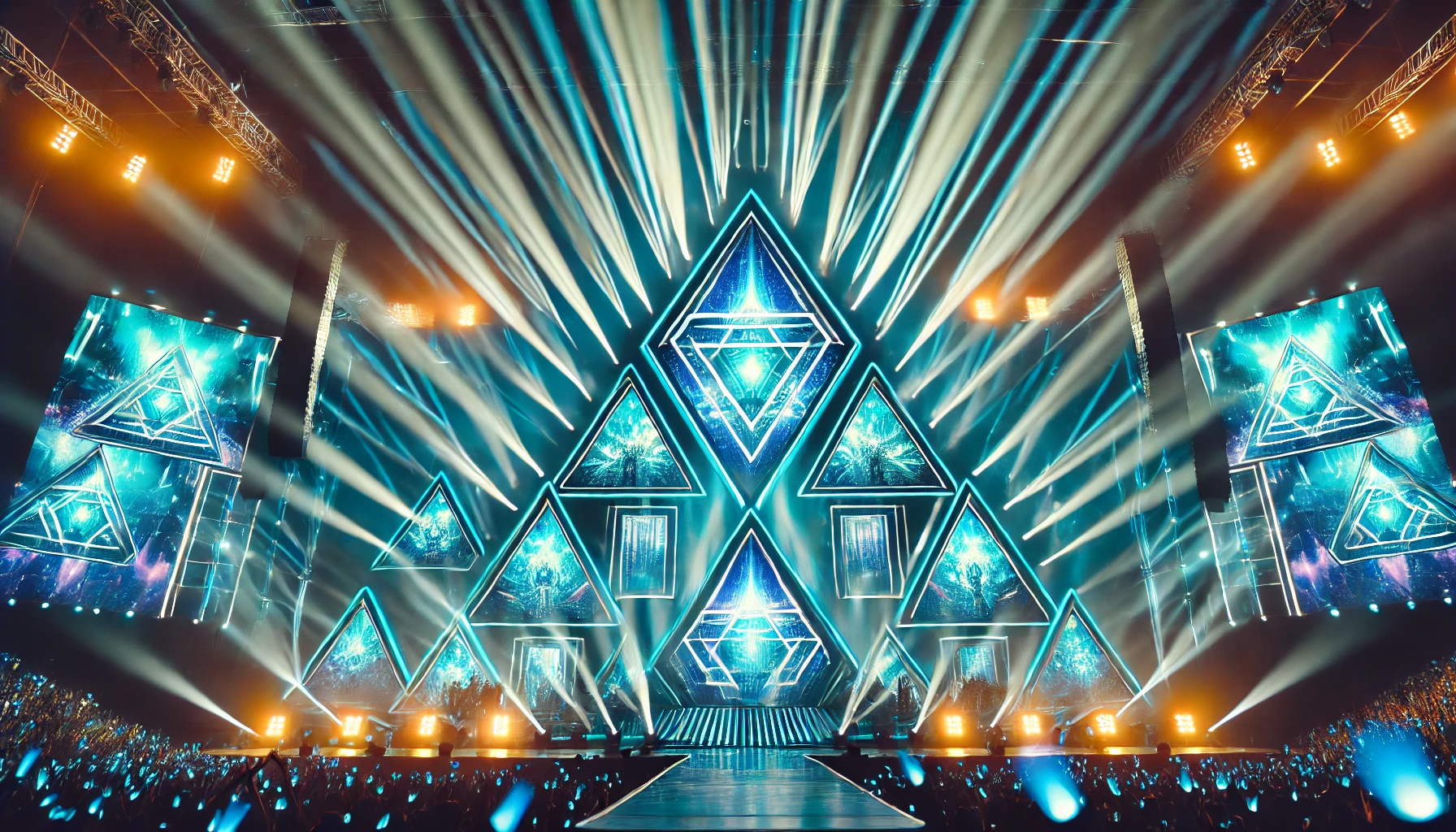
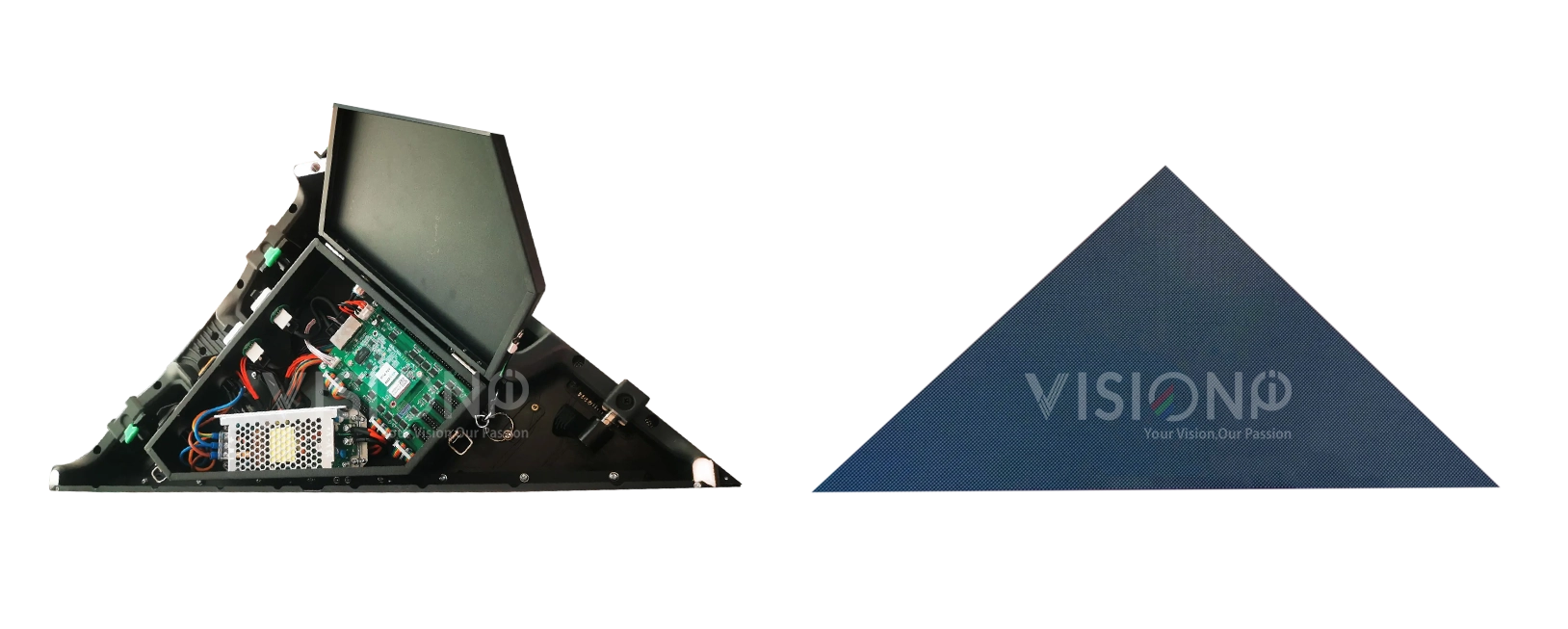
Conclusion
Triangle LED displays represent a cutting-edge solution in the field of LED technology, offering both functional and aesthetic benefits. Whether you’re looking to enhance a commercial space, captivate an audience at an event, or innovate in artistic expression, these displays provide a versatile and effective medium. With their ability to adapt to various settings and purposes, triangle LED displays are not just tools for display but catalysts for creativity and engagement.
For more insights and detailed information about our range of innovative LED solutions, visit our website or contact our expert team. Embrace the future of display technology with our high-quality, customizable LED solutions tailored to your needs.
Exploring the World of Immersive LED Displays
Immersive LED displays have transformed from commercial applications to exciting uses in naked-eye 3D and XR virtual shooting. LED Dome ,LED Cave they are now prominent in immersive showrooms, exhibitions, and virtual shooting bases. Immersive LED displays create personalized experiences and meet diverse shooting needs, surpassing the limitations of AR/VR glasses. Unlike wearable devices, these displays offer dynamic, compelling content that provides a truly three-dimensional experience.
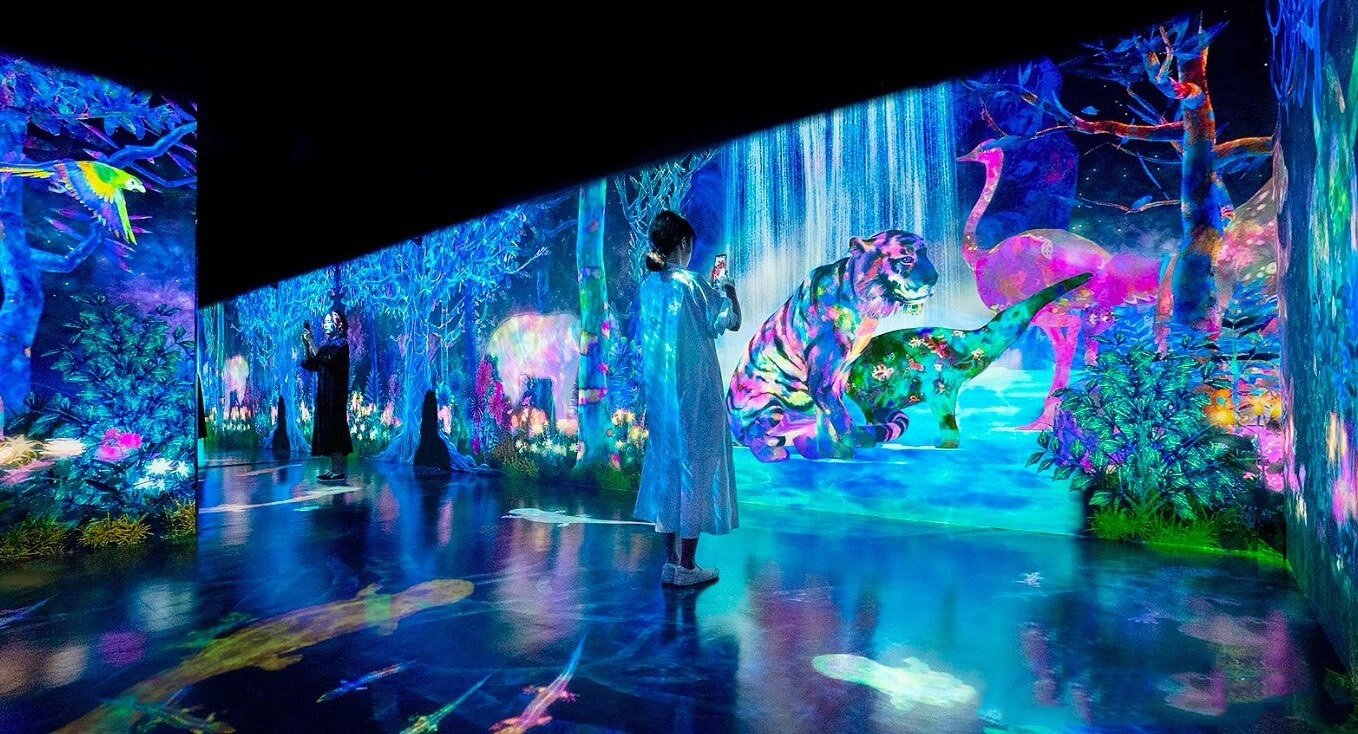

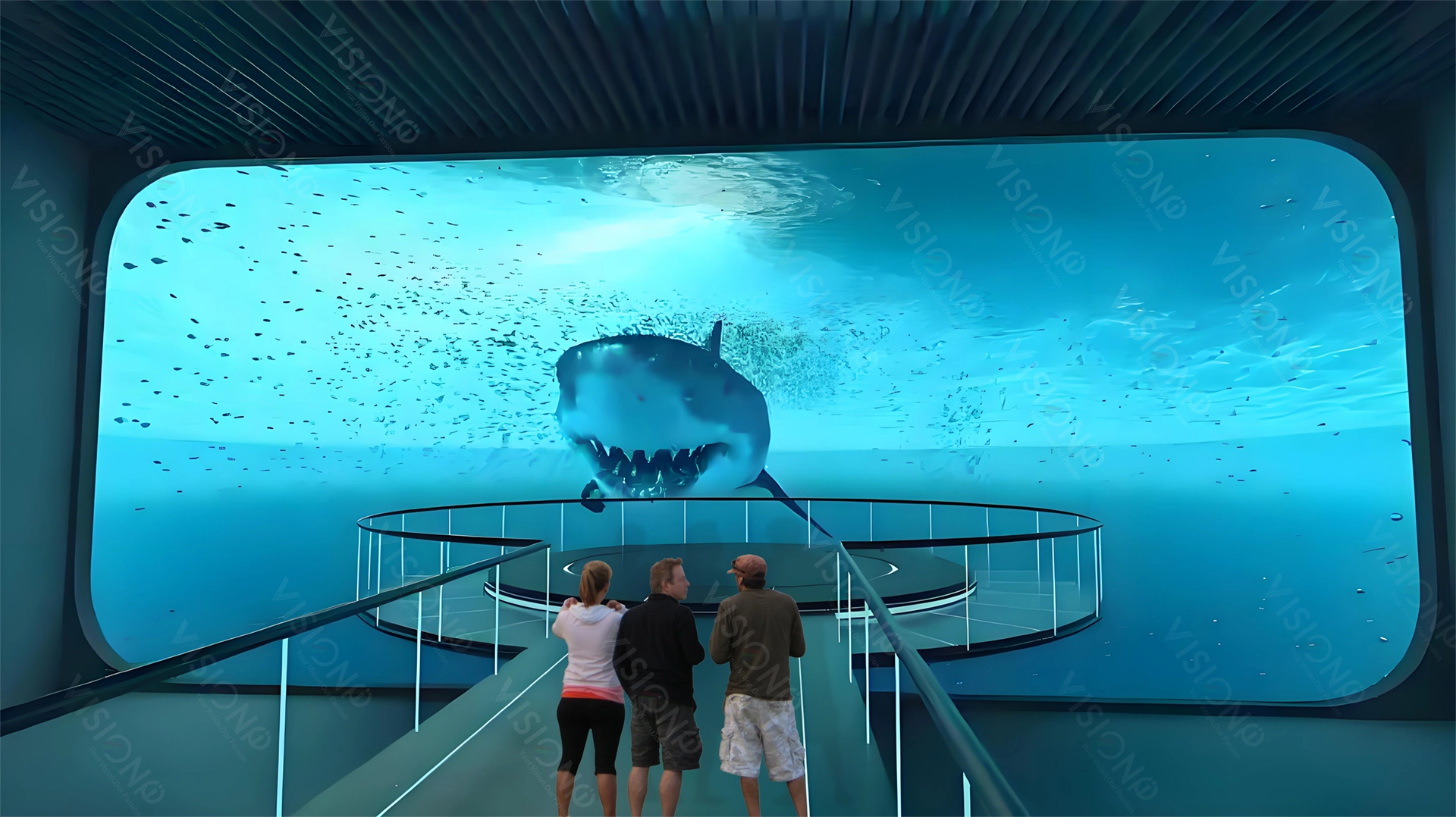
Immersive LED cube displays elevate brand representation by highlighting unique colors and brand values. Advertisers can create targeted ads, connecting with audiences emotionally and leaving a lasting impression.
These displays enhance learning by visually representing complex subjects. They are used in classrooms, libraries, auditoriums, and planetariums, making learning engaging and interactive.
From music streaming to large concerts, immersive LED displays provide clear, vivid visuals, enhancing the overall viewing experience and supporting wide and curved viewing angles.
Immersive LED cave screens offer fast response rates, maintaining high resolution and contrast levels, crucial for modern gaming experiences.
These displays enhance VR experiences, allowing audiences to explore diverse environments with special glasses and headsets.
Immersive LED Cave displays attract customer attention, showcasing products dynamically, increasing engagement, and boosting sales.
They bring exhibits to life with high-quality images and videos, providing a more engaging and educational experience for visitors.
Used in trade shows, product launches, and presentations, these displays showcase products and content dynamically, attracting attention and generating leads.
Large LED cave walls in airports, train stations, streets, and sports arenas reach a broad audience, making them ideal for advertising campaigns.
– LED Dome Display, LED Sphere Display ,LED Cave Display. Available in various sizes, these displays can be customized into vertical, tilted, or half-dome shapes.
-High Resolutions: Ultra-high dome master resolutions, such as 8K x 8K for 20m domes and up to 12K x 12K for 30m domes, ensure exceptional clarity.
– Acoustically Transparent: Display surfaces ensure clear, precise, and linear sound experiences.
– Lifetime Image Alignment: Consistent image quality in resolution, brightness, contrast, color space, and geometry.
– Reduced Operational Costs: Instant power up/down and modular monitoring reduce start- and end-of-day procedures.
– Full Accessibility: 100% rear accessibility with modular monitoring and diagnostics.
Our immersive LED dome display offers a captivating visual experience, wrapping audiences in a seamless, 360-degree environment. With high-resolution, distortion-free imagery and customizable configurations, this innovative display solution is perfect for planetariums, events, and experiential marketing. Its curved design ensures a uniform and immersive view from any angle, creating unforgettable moments and engaging storytelling opportunities.

LED Flying Theater is an immersive experience that combines cutting-edge motion simulation and dynamic seating to create a fully engaging ride. Passengers are seated in a suspended seating system, which moves in sync with stunning aerial view projections on a massive LED Dome Screen. This 360-degree surround view, paired with 4D effects like wind and scent, heightens the sensation of flight.
The theater offers visual sensory immersion with its ultra-high-definition visuals, creating a lifelike environment. This interactive entertainment setup allows passengers to feel like they are truly flying over breathtaking landscapes. Whether soaring over mountains or diving into the ocean, the experience is tailored to various thematic rides that engage all senses. The versatile design of LED Flying Theater makes it ideal for both interactive entertainment and corporate applications, offering a unique way to captivate audiences.
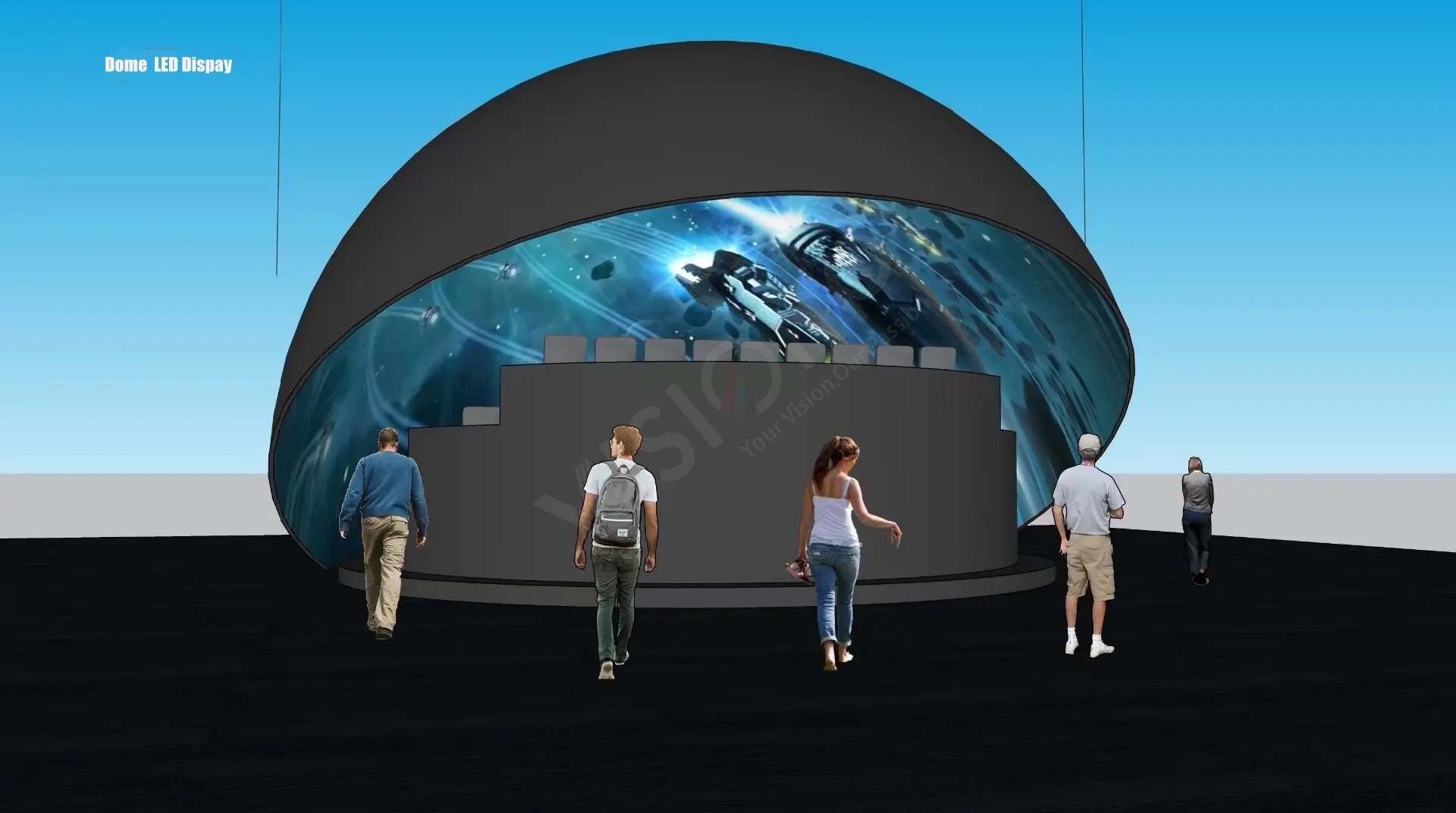
True Display Without Distortion
Experience a true display with no distortion or zooming, free from creases, edges, or corners. Our LED cave provides a real sense of immersion, making every visual detail come to life.

Smooth Display Without Creases
The curved corners feature customized soft modules, effectively solving the right-angle patchwork problem for a seamless viewing experience.
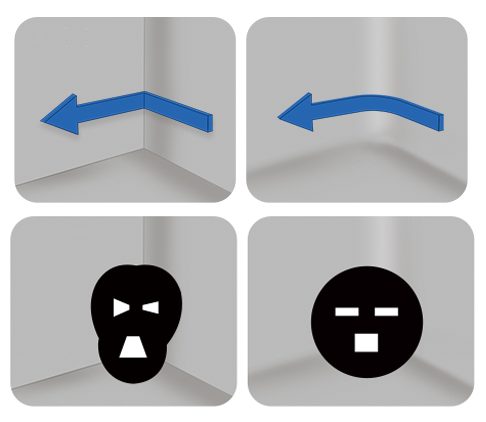
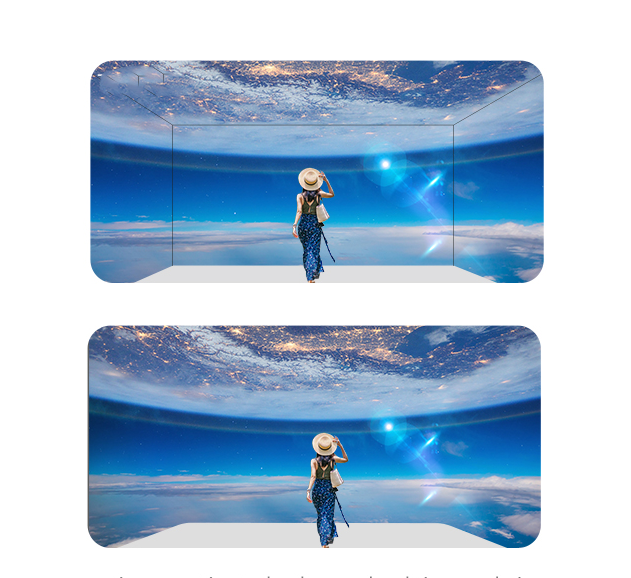
3-Sided Immersive LED Cave Display
This configuration includes two wall screens and one floor screen, offering a captivating and immersive experience with fewer components.
4-Sided Immersive LED Cave Screen
This setup includes three LED wall displays and either a ceiling or floor LED display, creating a 4-sided immersive environment with limitless possibilities for engaging visual experiences.
5-Sided Immersive LED Cave Screen
For the ultimate immersive experience, our 5-sided LED cave features three LED wall displays, a ceiling display, and a floor display. Seamlessly curved corners provide an unmatched sense of immersion for visitors.
An immersive LED tunnel display that encompasses three dimensions sounds like a visually stunning project. It combines LED walls, floors, and ceiling displays to create a 360-degree immersive visual environment. This type of setup can be particularly effective for exhibitions, immersive art installations, virtual reality environments, or themed entertainment venues.
Visionpi offers a comprehensive turn-key solution for immersive LED tunnel displays, which includes everything from the LED panels for walls, floors, and ceilings to the control systems and professional installation. This plug-and-play approach ensures that clients receive a fully operational setup without needing to manage complex technical details.
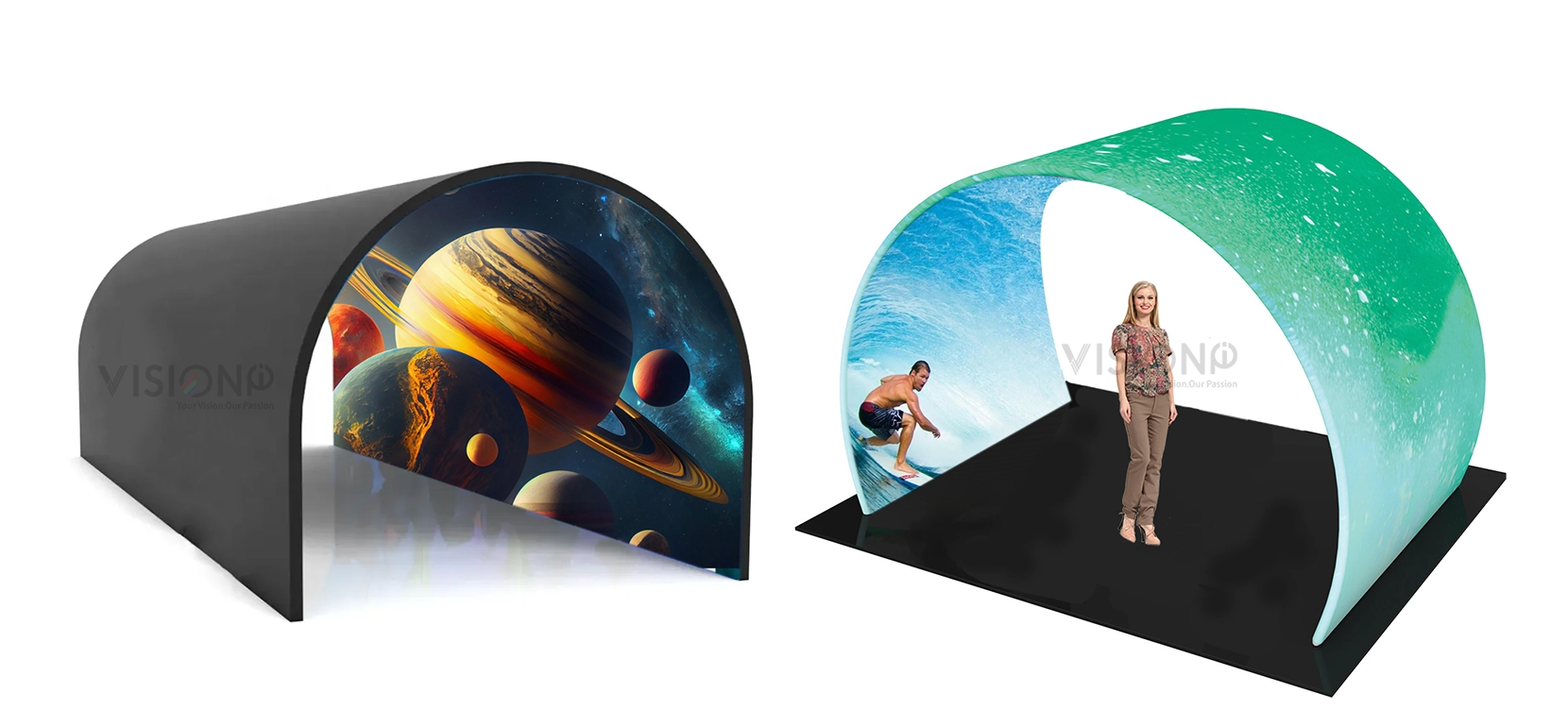
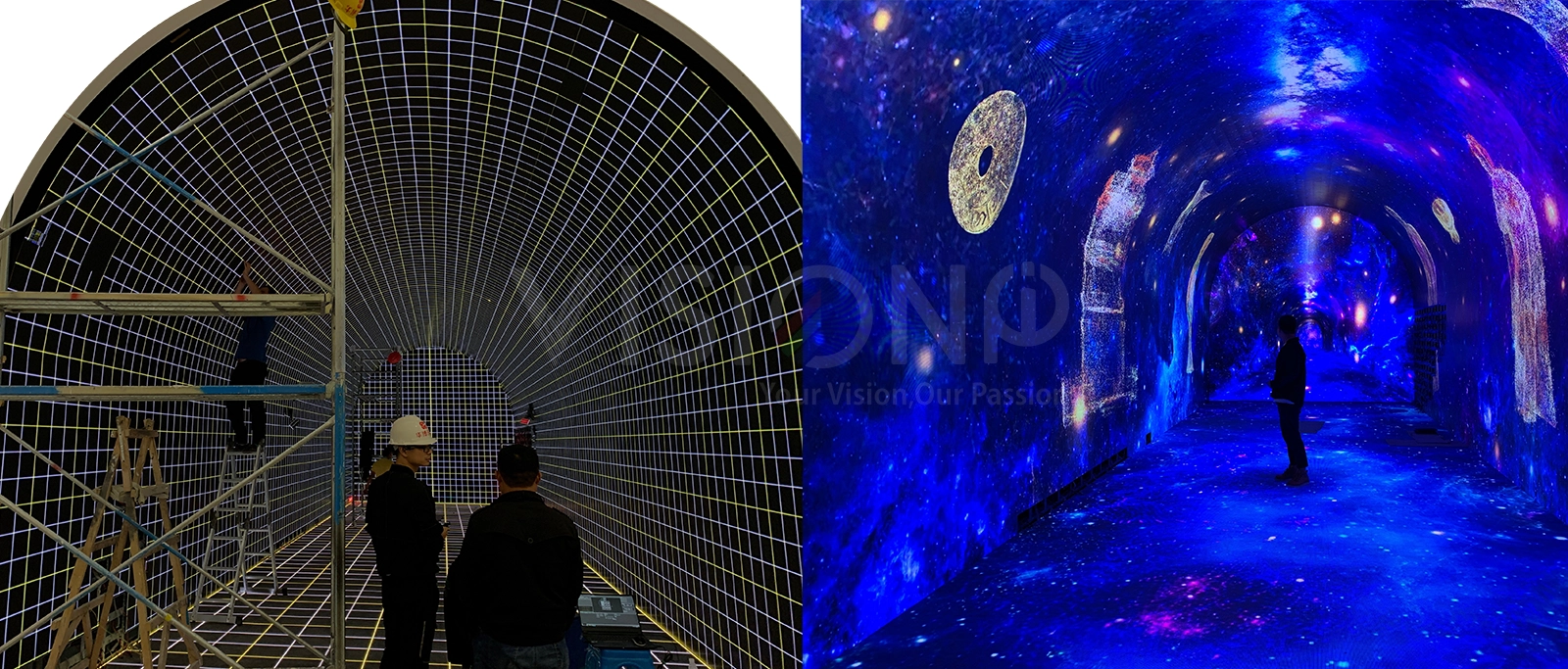
Custom Video Content
Tailored, high-quality video footage is crucial for achieving a 3D effect, enhancing the overall immersive experience and ensuring seamless integration with the display.
Advanced Control Systems
Utilizing a professional control system is essential for maintaining synchronization and delivering consistent visual effects across multiple display angles, creating a cohesive experience.
Premium LED Panels
High-resolution, high-refresh-rate LED panels are vital for providing clear, smooth visuals, which are key to an effective and engaging immersive display.
– High Frame Rates: Capable of 120 fps for crisp images, even with fast motion.

Why Choose Visionpi LED Immersive Display Solutions
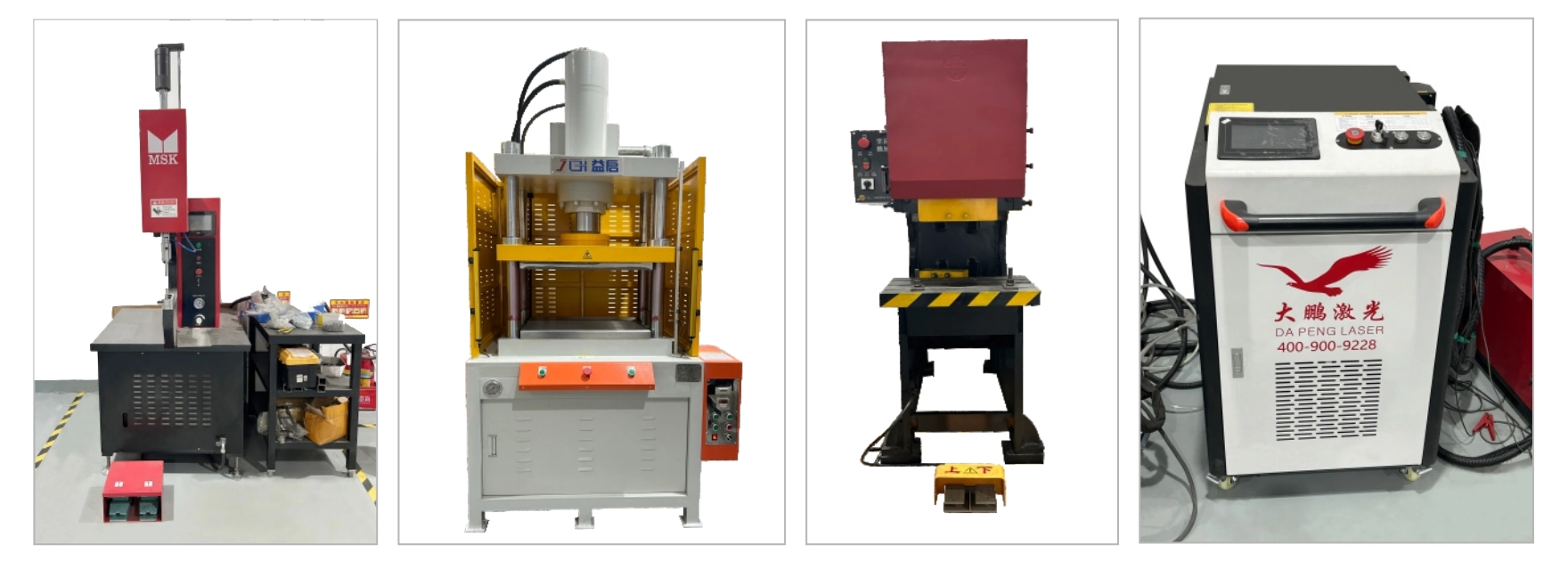
Elevate your visual experiences with our state-of-the-art immersive LED dome display. Contact us today to explore how our innovative solutions can transform your events and installations into unforgettable visual journeys. Let’s create something extraordinary together!
The taxi top LED display, also known as the cabs top LED screen, is an innovative advertising solution that utilizes car roof LED signage to capture attention and deliver dynamic content to a wide audience. This cutting-edge technology transforms ordinary cabs into mobile billboards, providing a highly visible platform for advertisements, promotions, and public announcements.
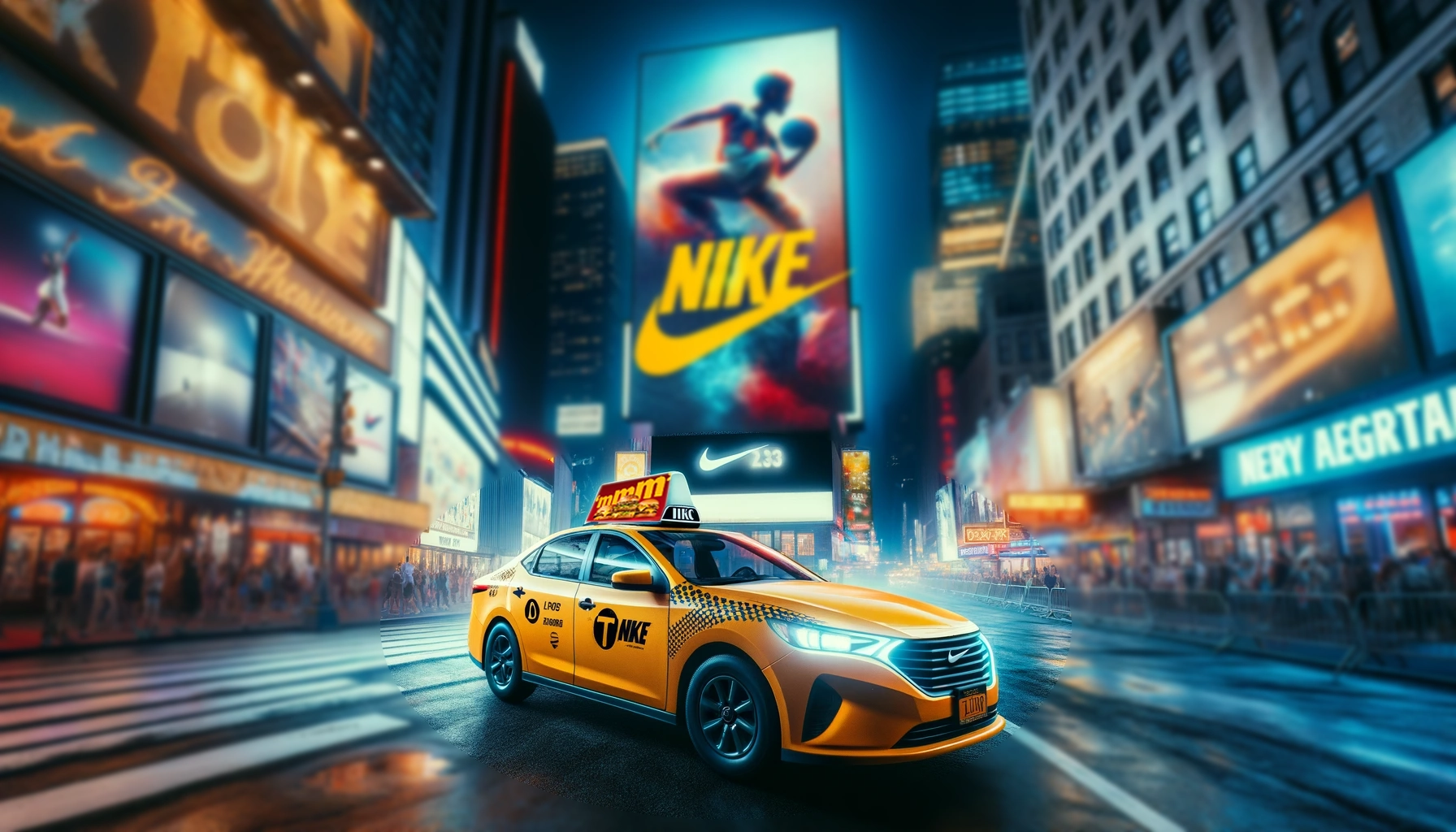
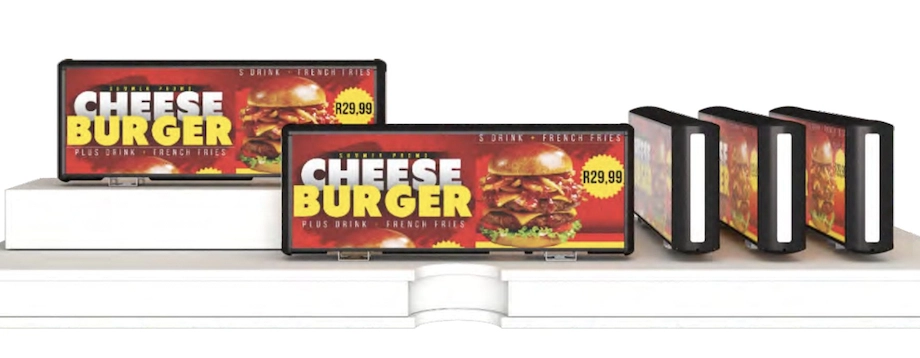

In the fast-paced world of advertising, staying ahead of the curve is crucial. Traditional static billboards and print ads are losing their impact in the face of more dynamic, engaging solutions. Enter VisionPi’s taxi top LED display – a cutting-edge mobile media platform that revolutionizes how businesses reach their audience. This innovative vehicle-mounted LED display leverages mobility to deliver targeted, real-time content, making it a game-changer in the advertising industry.
Mobility Generates Value
VisionPi’s taxi roof LED sign transforms ordinary taxis into mobile advertising powerhouses. Unlike traditional media, this advanced display system uses built-in GPS technology to switch advertisements intelligently based on location and traffic information. This means your ads are always relevant, reaching the right audience at the right time. Whether it’s bustling city streets or quieter suburban roads, VisionPi ensures maximum visibility and engagement for your brand.
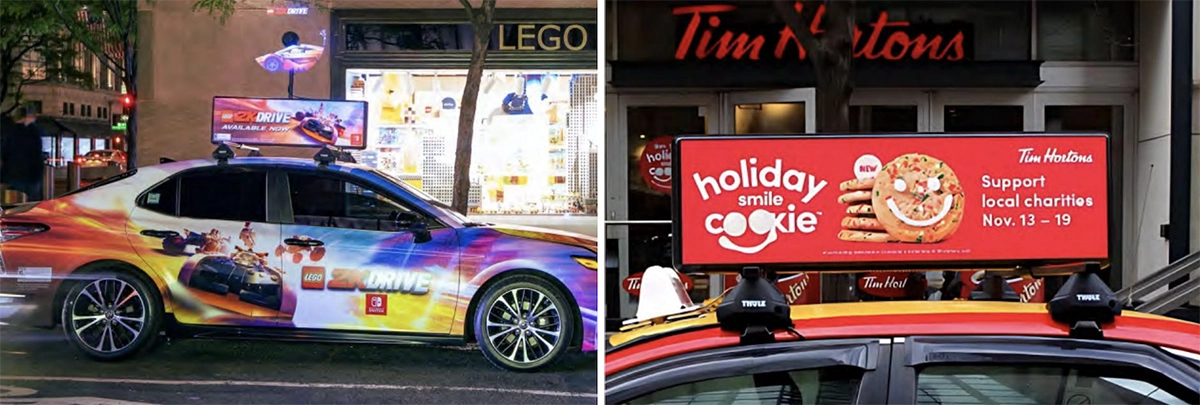
Transform your advertising strategy with our innovative double-sided taxi top LED display. Designed for maximum visibility, this high-resolution display showcases vibrant, dynamic content on both sides, ensuring your message reaches a wide audience from every angle. Built with energy-efficient LEDs, it offers exceptional brightness and clarity in all lighting conditions, day or night. Its robust, weather-resistant construction guarantees durability and reliable performance in any environment. Ideal for urban settings, our taxi top LED display is the perfect solution for brands looking to enhance their presence and captivate potential customers on the move.
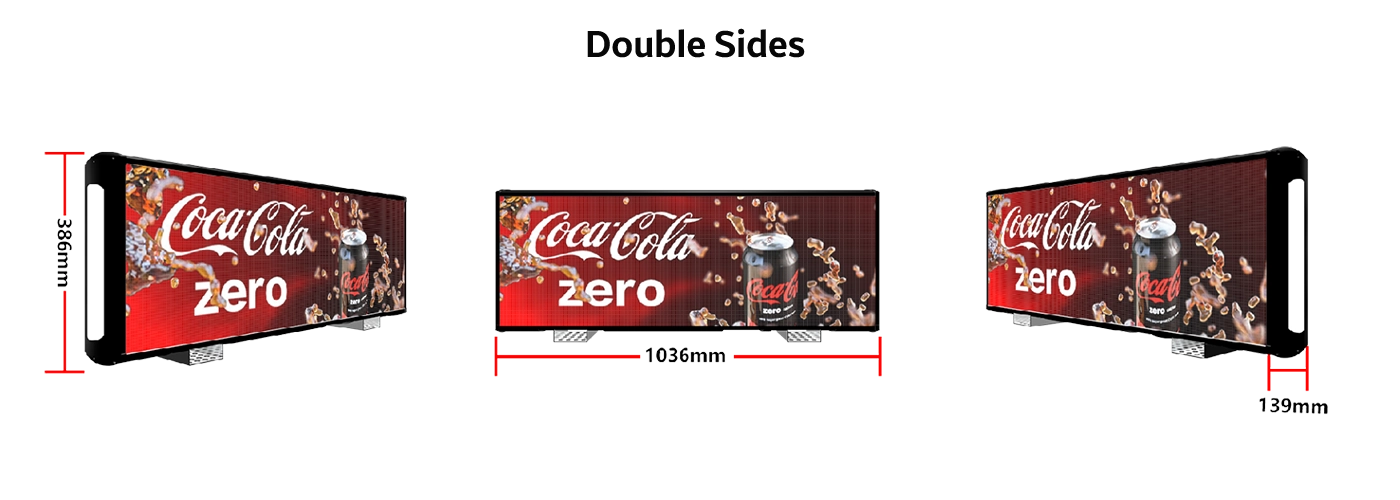
VisionPi’s taxi top LED display is designed with energy efficiency in mind. Consuming an average of just 100W, it features a built-in brightness sensor that adjusts the display’s brightness intelligently. During the day, the brightness increases to ensure visibility, while at night, it decreases to save energy. The precise power input technology, which powers red and blue diodes separately, results in 50% less power consumption compared to traditional LED displays.
Managing your advertising content has never been easier. With VisionPi’s taxi top LED display, you can control all displays from a single terminal on your mobile phone, computer, or iPad. The smart playlist feature ensures that commercials are displayed based on traffic and location. As a taxi enters a specific area, the system can automatically display targeted ads, maximizing the impact of your advertising campaign.
Flexible Track Design
The innovative track design allows the VisionPi car top LED advertising screen to be fixed on the car and slid to different positions, enhancing the flexibility and readability of the content. This feature ensures that your ads are always displayed at the optimal angle, making them more engaging and effective.
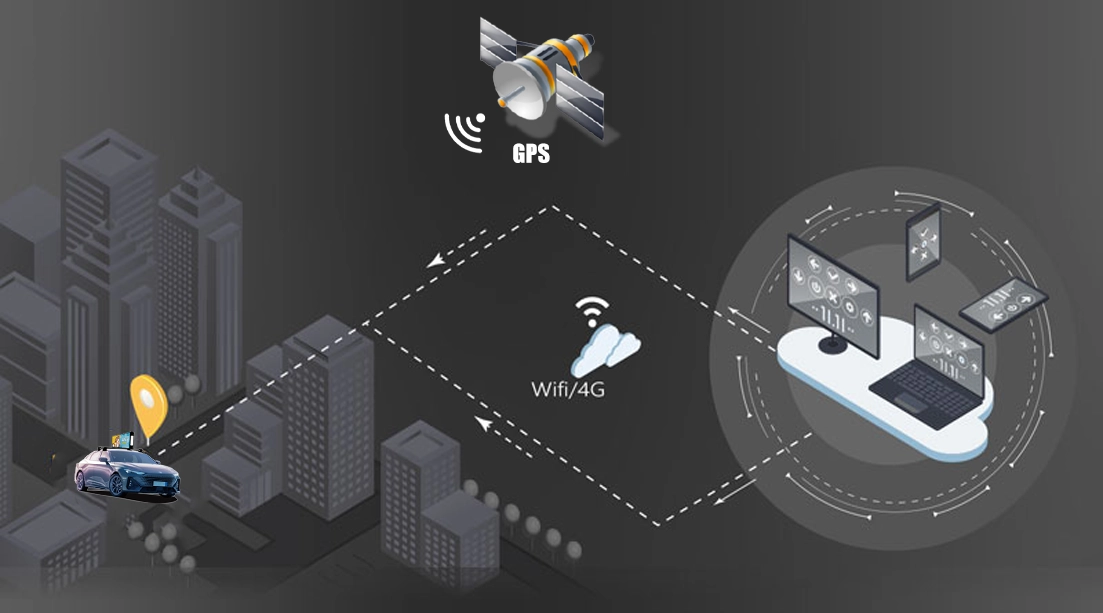
VisionPi’s taxi top advertising screen boasts an impressive IP65 ingress protection rating, making it fully weatherproof and shockproof. The transparent PC cover protects the diodes, while the aluminum alloy power module efficiently conducts heat generated inside. Additional features such as electrostatic prevention and lightning protection ensure the display’s durability and reliability for long-term use.
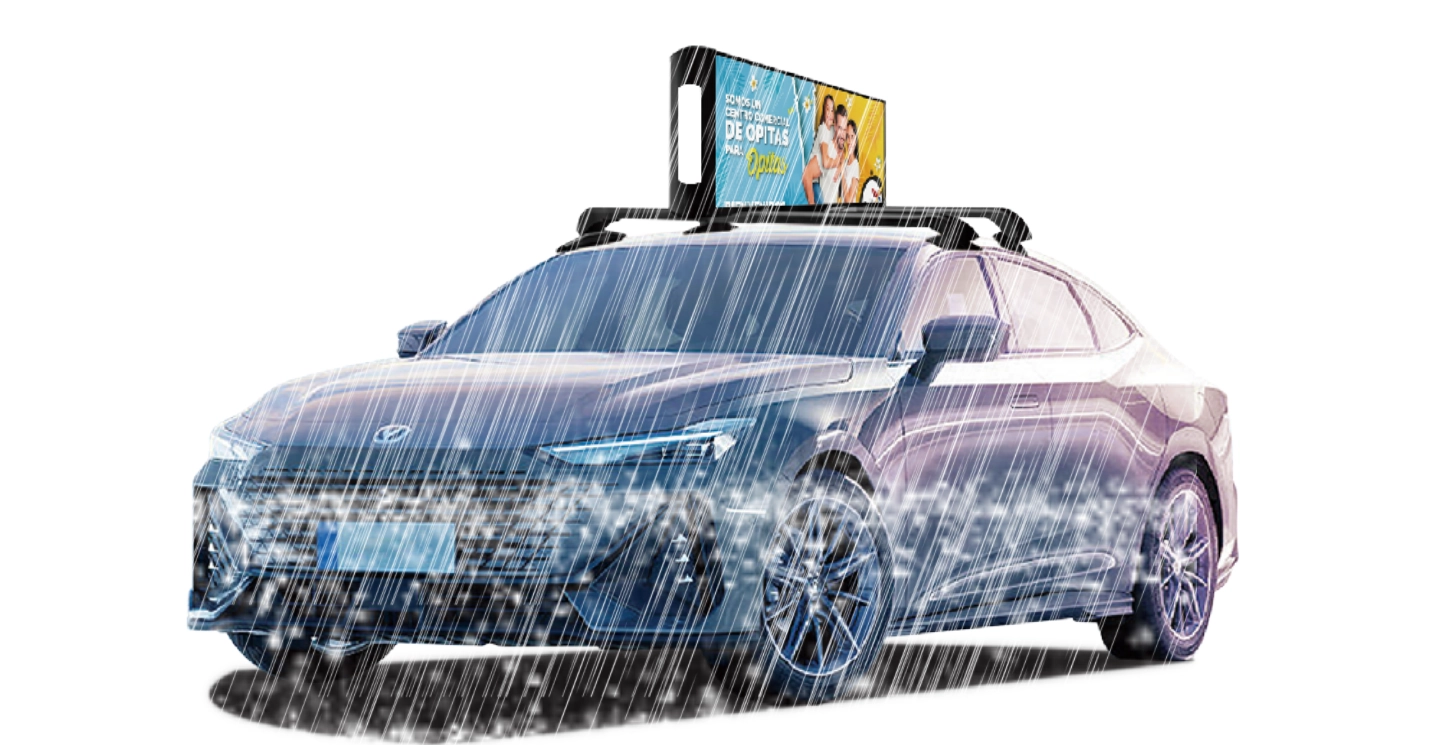
One of the standout features of VisionPi’s taxi roof LED sign is its slim and lightweight design. The cabinet weighs only 13kg, with the thinnest part measuring just 3.3cm. This aerodynamic design reduces wind load, making it an ideal choice for vehicle-mounted LED displays. The sleek design ensures that the display integrates seamlessly with the taxi’s roof without compromising on performance.
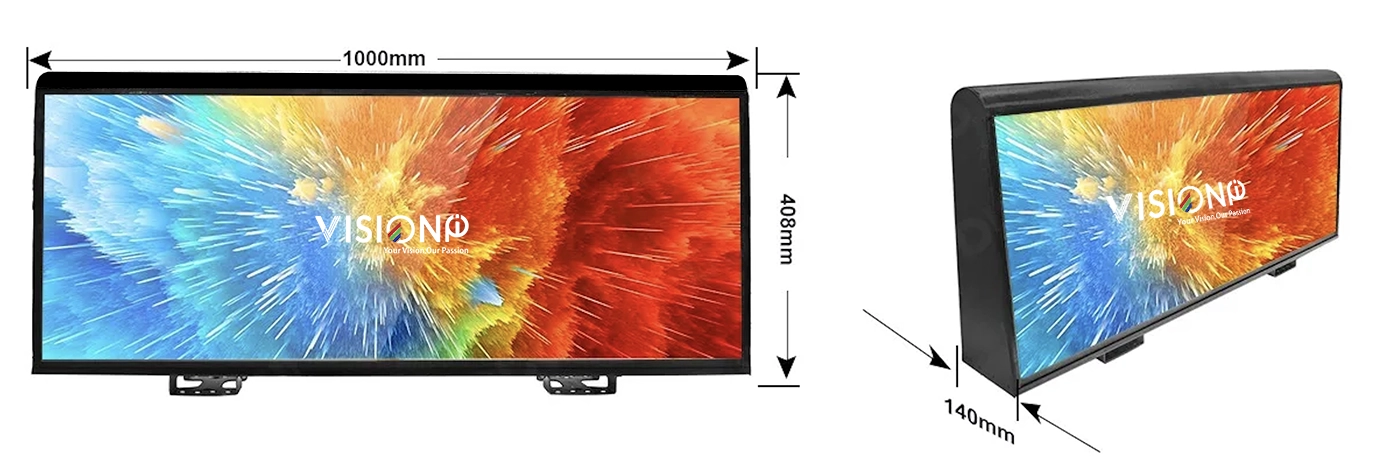
VisionPi’s taxi top LED display consumes an average of 70W, thanks to its intelligent brightness adjustment system. The built-in brightness sensor automatically increases the brightness during the day and decreases it at night, optimizing power consumption while maintaining visibility. This feature ensures that your ads are always seen, day or night, without wasting energy.
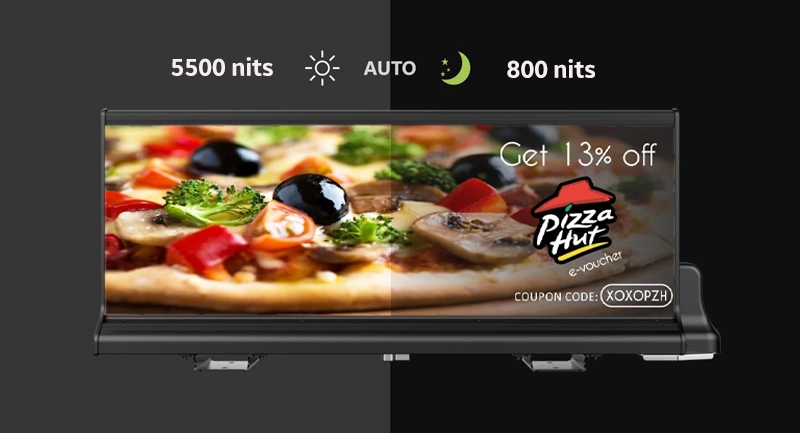
VisionPi’s taxi top LED display is designed for effortless maintenance. The cabinet can be accessed and serviced from the side, while the modules are accessible from the front. This design allows for quick and easy maintenance, minimizing downtime and ensuring your ads are always on display.
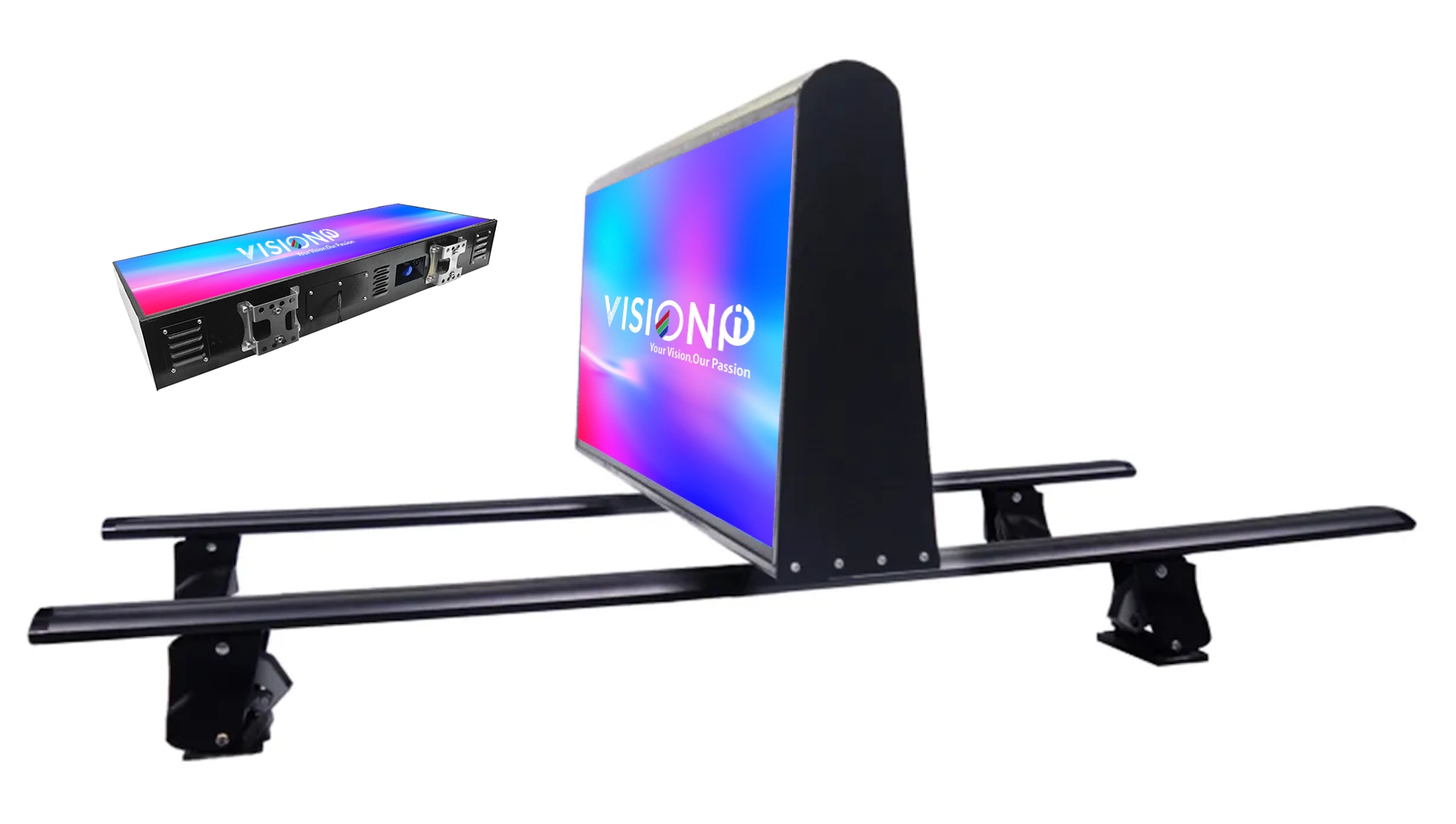
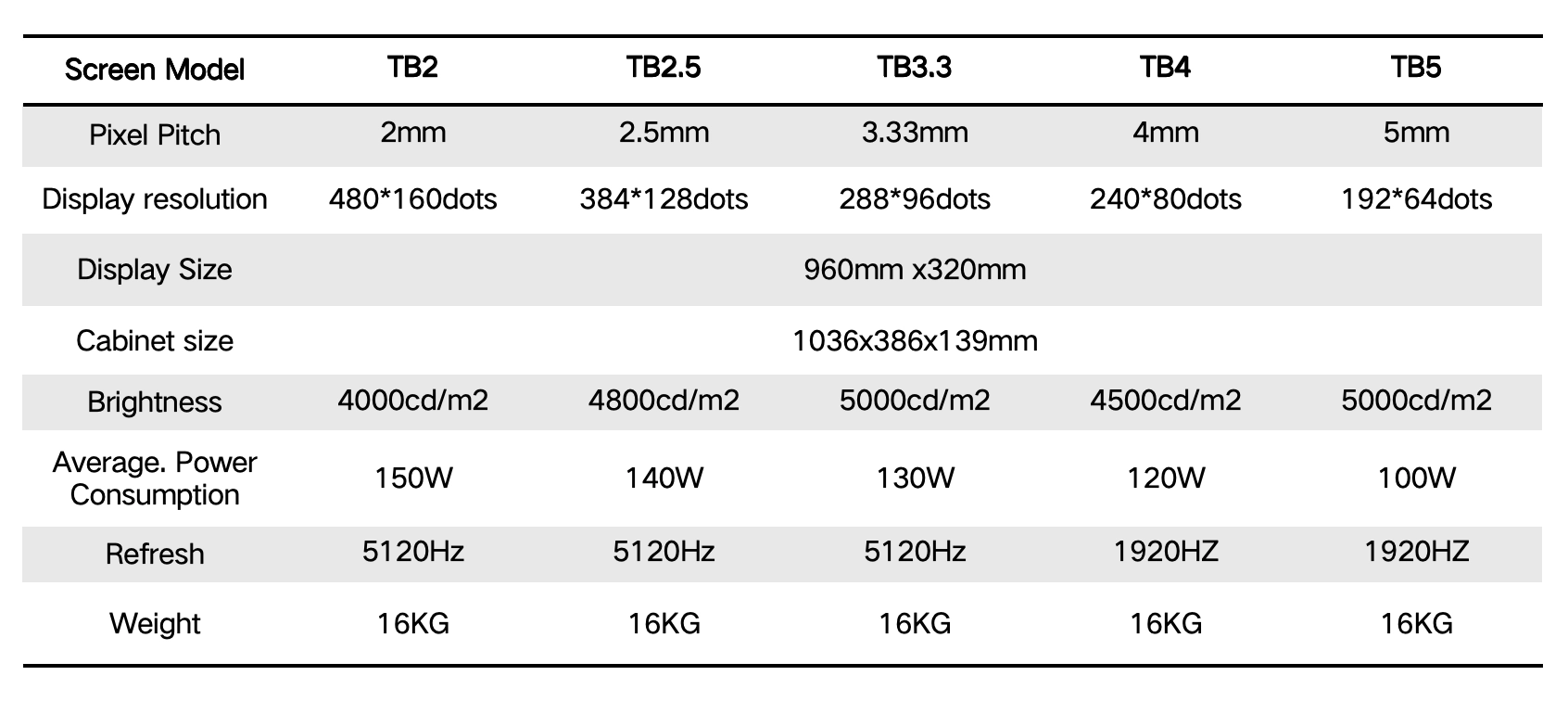
Ready to elevate your advertising game? VisionPi’s taxi top LED display offers a dynamic, energy-efficient, and easy-to-maintain solution tailored for modern advertising needs. With its intelligent content switching, robust design, and advanced features, it’s the ideal choice for businesses aiming to maximize their advertising reach. Don’t miss out on the future of advertising – contact us today to learn more about how VisionPi can transform your advertising strategy and drive your brand visibility to new heights.
These innovative Car window transparent led displays transform ordinary car windows into dynamic communication tools, capable of showing colorful or monochrome messages and advertisements. Designed to enhance vehicle-to-pedestrian interaction, they offer a new way for cars to convey important information or engaging ads to people walking by. This cutting-edge technology not only redefines the functionality of car windows but also opens up new possibilities for urban advertising and safety communication. Discover how our transparent window displays are revolutionizing the way cars communicate with the world around them.
LED displays are widely used in museums for interactive and informative presentations. However, traditional LED displays have a significant drawback: when turned off, they leave a large, black area that disrupts the aesthetic decor of the museum, detracting from the overall visitor experience.
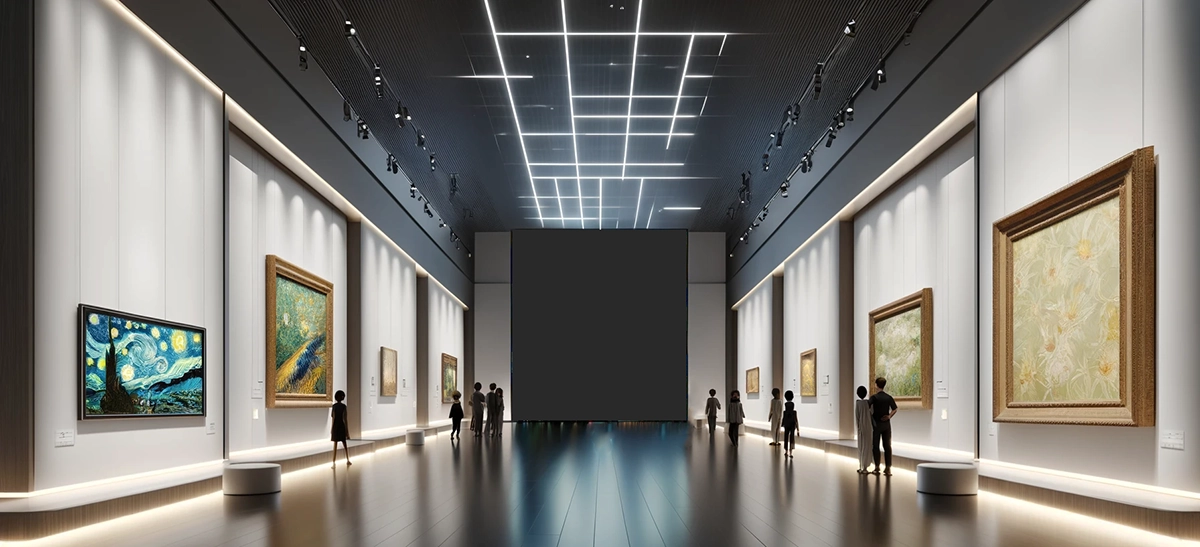
Experience the future of visual display technology with Texture LED Display. Our revolutionary display combines high-quality visual output with an elegant, adaptable design, enhancing both functionality and aesthetics.
Enhanced Visual Experience: Provides vibrant, high-resolution displays.
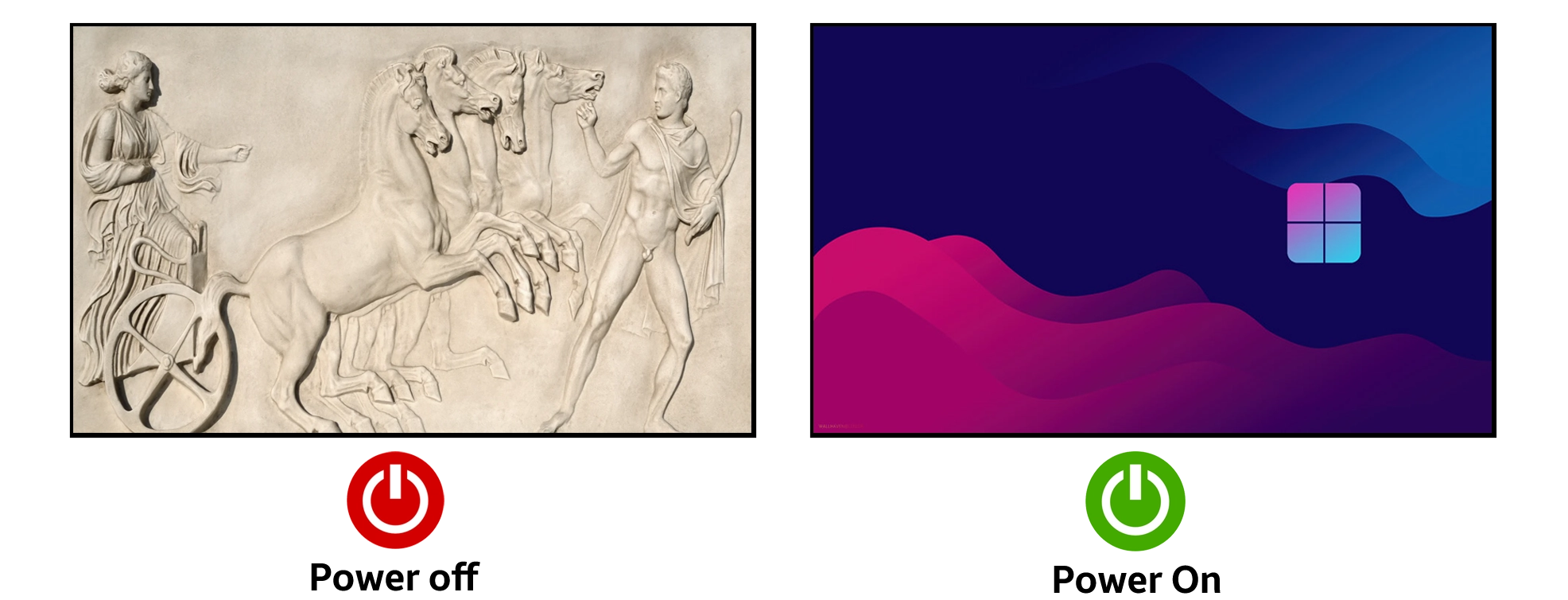
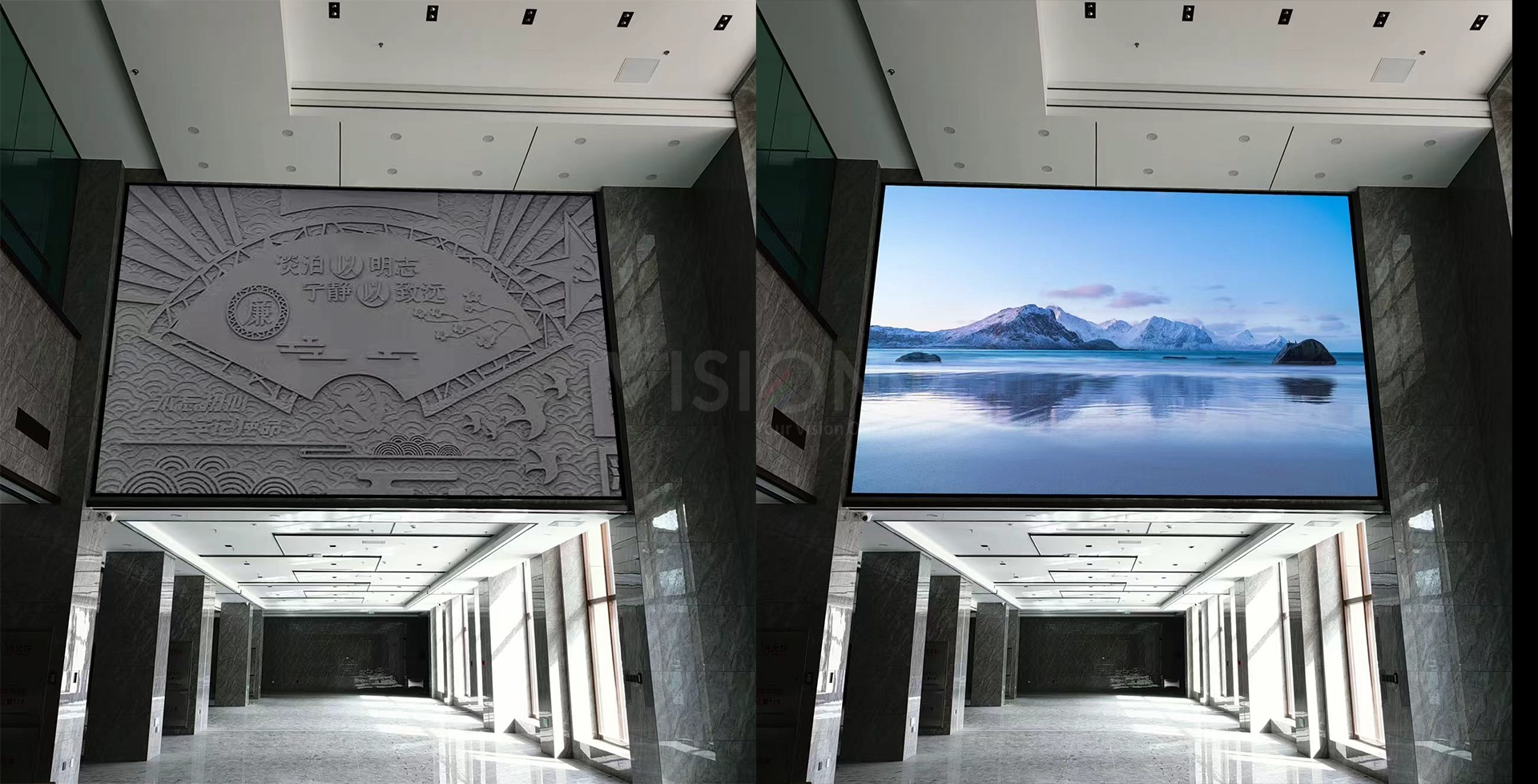
Imagine walking through a renowned art museum where technology and history converge to create an unforgettable visitor experience. As you approach a beautifully framed painting, you notice the BlendView LED Display seamlessly integrated into the wall, appearing as a sophisticated wooden panel that matches the museum’s elegant decor.
Suddenly, the wall comes to life, transitioning into a vibrant, high-resolution screen. It presents an interactive video about the painting, sharing its history, the artist’s inspiration, and intricate details. Visitors are captivated by the immersive experience, allowing them to zoom in on brushstrokes, compare it with other works, and watch interviews with art historians, all without leaving their spot.
In another section, the BlendView LED Display dynamically adapts to different exhibitions, providing themed backgrounds and enhancing storytelling. When displaying ancient artifacts, it blends with the classical architecture, maintaining the aesthetic integrity of the museum.

The BlendView LED Display is also perfect for outdoor facade projects, seamlessly integrating with architectural designs:

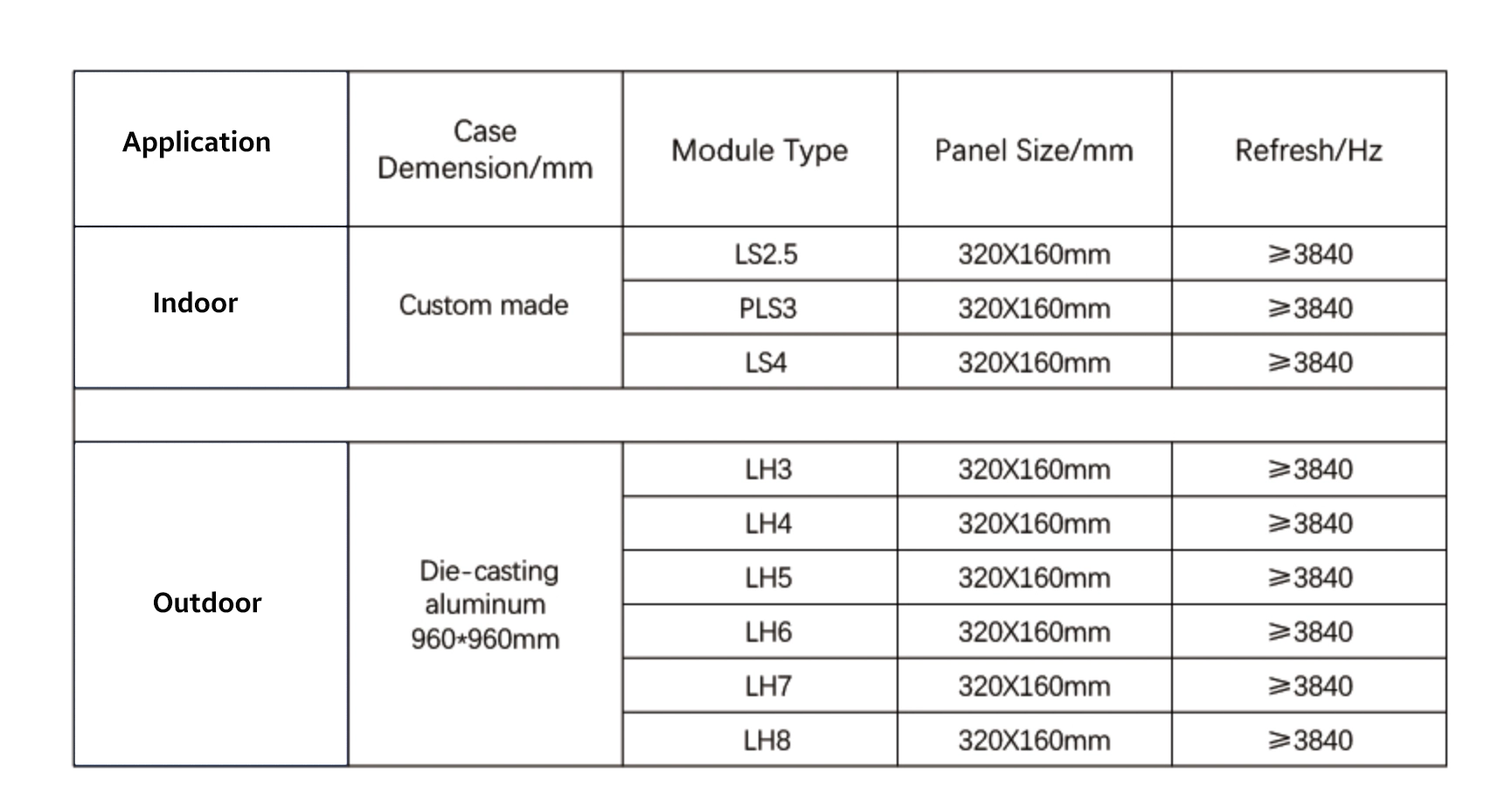
Transform Your Space Today!
Ready to revolutionize your environment with the BlendView LED Display? Contact us now to learn more about how our innovative technology can enhance your museum exhibitions and outdoor projects. Don’t miss the opportunity to captivate and impress your audience with a solution that perfectly blends functionality and aesthetics.
Revolutionize Your Delivery Service with Our Advanced LED Delivery Box
In the competitive world of delivery services, standing out is crucial. Our innovative LED delivery box for motorcycles is not just a functional tool but a dynamic advertising platform. Here’s how this cutting-edge product can elevate your business visibility and streamline operations, embedding practicality with high-end technology.
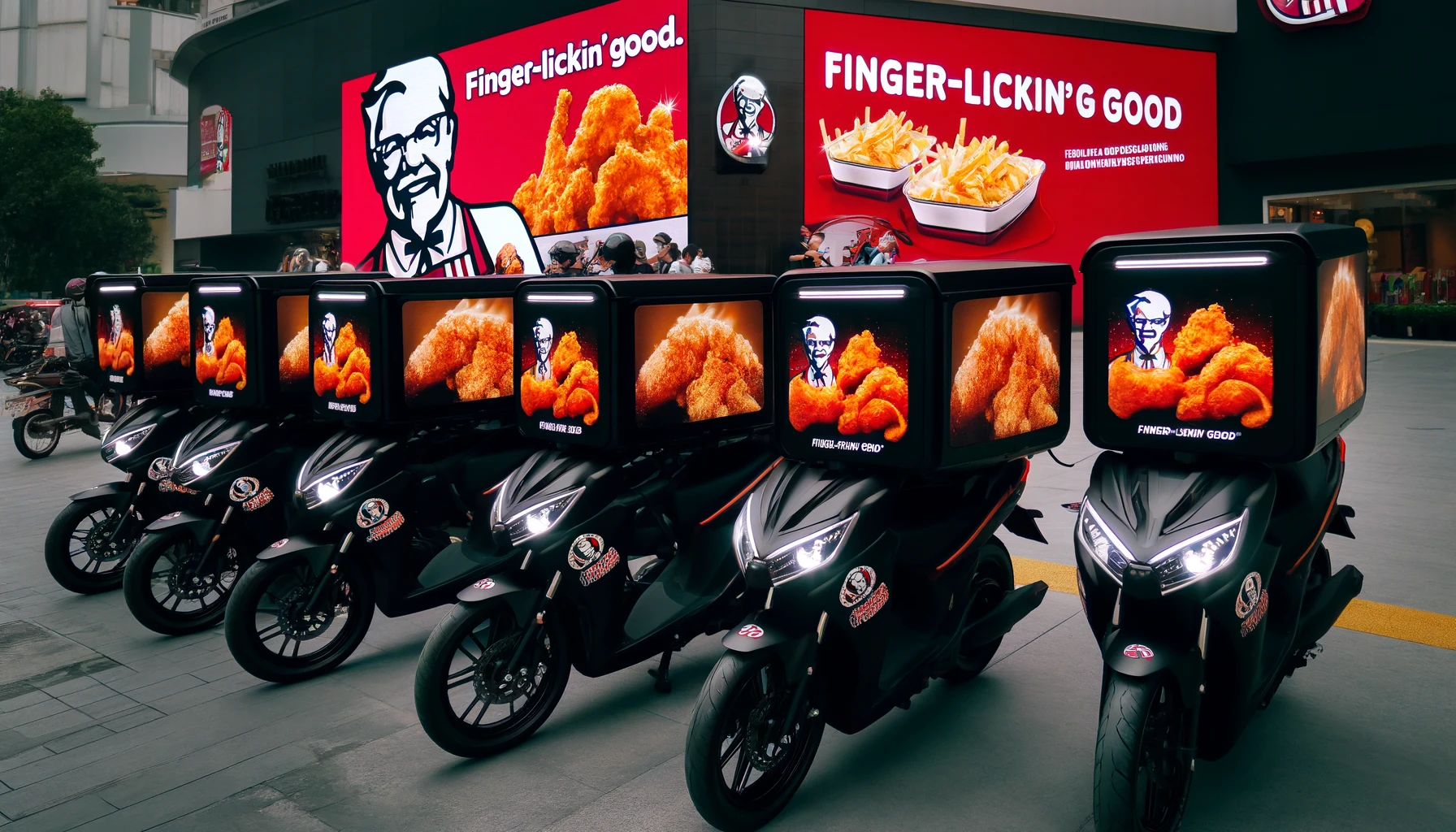
Dynamic Advertising on the Go
– Multiple Display Options: Choose from 1-side, 2-sides, or 3-sides advertising boards to maximize visibility from different angles. Whether you’re cruising through city streets or parked at busy venues, your message gets phenomenal exposure.
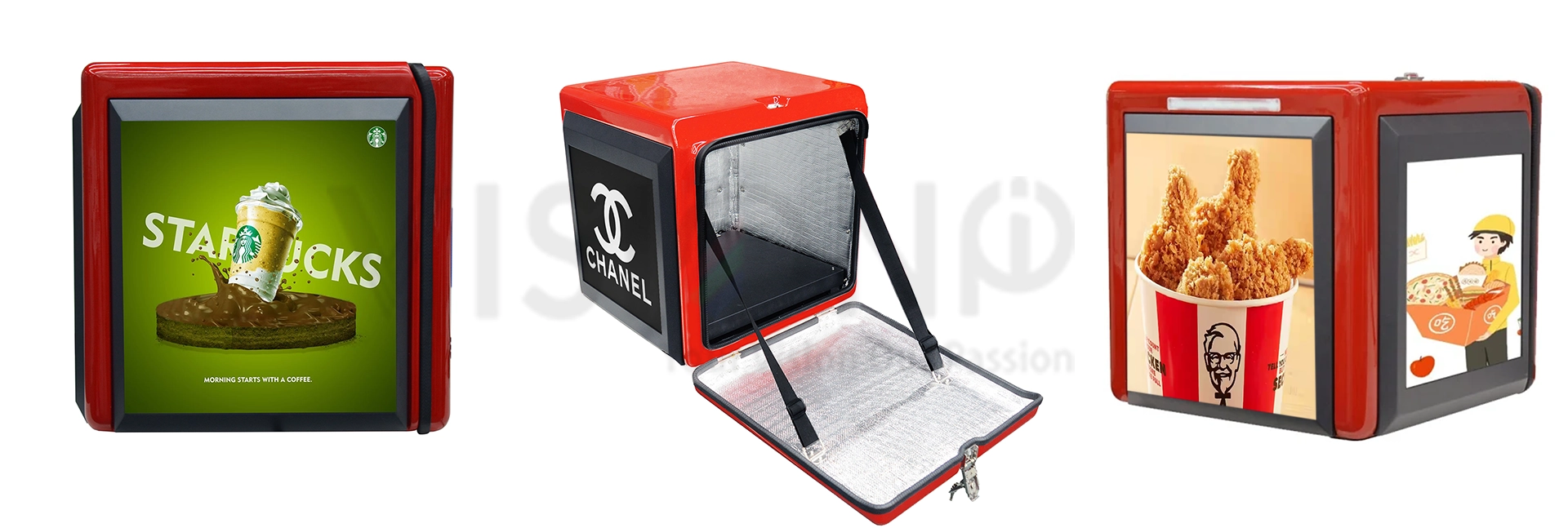
Customizable Displays: Tailor your marketing campaigns with our customizable color, size, and design options. The delivery box features a substantial display area of 384×348 mm within a 500x500x500 mm box, perfect for capturing attention.
Technologically Advanced Features
Sustained Operational Efficiency:The LED box is designed to work seamlessly for 8 hours using the motorcycle battery, making it an efficient tool for day-long advertising without frequent recharges.
Real-Time Tracking and Control: Equipped with precise GPS positioning and trajectory tracking, you can monitor and locate your fleet anytime, anywhere. This feature enhances the security and efficiency of your delivery service.
Online Advertisement Updates: Update and manage your advertisements in real-time with our online group control feature. This allows for seamless content updates and campaign adjustments on the go, keeping your marketing fresh and engaging.
Unmatched Safety and Durability
– Robust Waterproof Design: Our delivery boxes are built to withstand the elements, making them ideal for use in any weather conditions. The waterproof design ensures your advertisements and goods are protected.
Comprehensive Security Design: Featuring a four-layer protection system:
– Level One: Industrial-grade power supply with vehicle ACC system control, ensuring equipment safety when not in operation.
– Level Two: A 25A fuse at the power converter’s front end offers secondary protection against electrical mishaps.
– Level Three: Dedicated protection fuses for each power converter guard against overvoltage, overcurrent, and misconnections.
– Level Four: Customized 40-second delay start to minimize electrical interference and protect vehicle operations.
Why Choose Our LED Delivery Box?
– Versatile and Eye-catching: Make your delivery bikes mobile billboards that capture attention while ensuring the safe transport of goods.
– Energy Efficient: With a low power consumption of approximately 15W during start-up, it’s designed to be economical without straining the vehicle’s battery.
– Advanced Security Features: Peace of mind with multi-tiered protection that safeguards both the equipment and the vehicle.